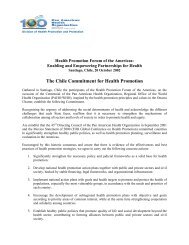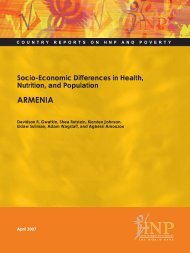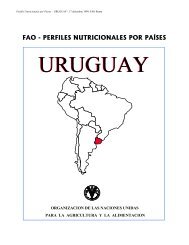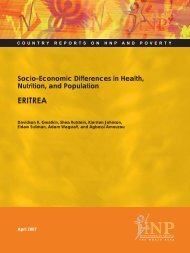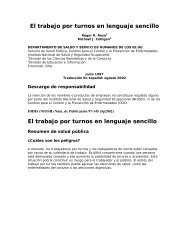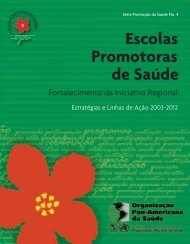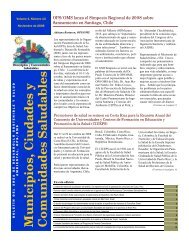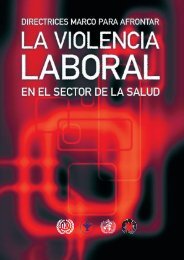Guidelines for drinking-water quality. Volume 1 - BVSDE
Guidelines for drinking-water quality. Volume 1 - BVSDE
Guidelines for drinking-water quality. Volume 1 - BVSDE
Create successful ePaper yourself
Turn your PDF publications into a flip-book with our unique Google optimized e-Paper software.
derivation of TDIs used in developing guideline values <strong>for</strong> <strong>drinking</strong>-<strong>water</strong> <strong>quality</strong>.<br />
ADIs are established <strong>for</strong> food additives and pesticide residues that occur in food <strong>for</strong> necessary<br />
technological purposes or plant protection reasons. For chemical contaminants, which usually<br />
have no intended function in <strong>drinking</strong>-<strong>water</strong>, the term “tolerable daily intake” is seen as more<br />
appropriate than “acceptable daily intake,” as it signifies permissibility rather than acceptability.<br />
As TDIs are regarded as representing a tolerable intake <strong>for</strong> a lifetime, they are not so precise that<br />
they cannot be exceeded <strong>for</strong> short periods of time. Short-term exposure to levels exceeding the<br />
TDI is not a cause <strong>for</strong> concern, provided the individual’s intake averaged over longer periods of<br />
time does not appreciably exceed the level set. The large uncertainty factors generally involved in<br />
establishing a TDI (see below) serve to provide assurance that exposure exceeding the TDI <strong>for</strong><br />
short periods is unlikely to have any deleterious effects upon health. However, consideration<br />
should be given to any potential acute toxic effects that may occur if the TDI is substantially<br />
exceeded <strong>for</strong> short periods of time.<br />
The calculated TDI was used to derive the guideline value, which was then rounded to one<br />
significant figure. In some instances, ADI values with only one significant figure set by JECFA or<br />
JMPR were used to calculated the guideline value. The guideline value was generally rounded to<br />
one significant figure to reflect the uncertainty in animal toxicity data and exposure assumptions<br />
made. More than one significant figure was used <strong>for</strong> guideline values only where extensive<br />
in<strong>for</strong>mation on toxicity and exposure to humans provided greater certainty.<br />
No-observed-adverse-effect level and lowest-observed-adverse-effect level<br />
The NOAEL is defined as the highest dose or concentration of a chemical in a single study, found<br />
by experiment or observation, that causes no detectable adverse health effect. Whenever<br />
possible, the NOAEL is based on long-term studies, preferably of ingestion in <strong>drinking</strong>-<strong>water</strong>.<br />
However, NOAELs obtained from short-term studies and studies using other sources of exposure<br />
(e.g., food, air) may also be used.<br />
If a NOAEL is not available, a LOAEL may be used, which is the lowest observed dose or<br />
concentration of a substance at which there is a detectable adverse health effect. When a LOAEL<br />
is used instead of a NOAEL, an additional uncertainty factor is normally used (see below).<br />
Uncertainty factors<br />
The application of uncertainty factors has been widely used in the derivation of ADIs <strong>for</strong> food<br />
additives, pesticides, and environmental contaminants. The derivation of these factors requires<br />
expert judgement and a careful sifting of the available scientific evidence.<br />
In the derivation of the WHO <strong>drinking</strong>-<strong>water</strong> <strong>quality</strong> guideline values, uncertainty factors were<br />
applied to the lowest NOAEL or LOAEL <strong>for</strong> the response considered to be the most biologically<br />
significant and were determined by consensus among a group of experts using the approach<br />
outlined below:<br />
Source of uncertainty<br />
Factor<br />
Interspecies variation (animals to humans) 1-10<br />
Intraspecies variation (individual variations) 1-10<br />
Adequacy of studies or database 1-10<br />
Nature and severity of effect 1-10<br />
Inadequate studies or databases include those that used a LOAEL instead of a NOAEL and<br />
studies considered to be shorter in duration than desirable. Situations in which the nature or<br />
severity of effect might warrant an additional uncertainty factor include studies in which the endpoint<br />
was mal<strong>for</strong>mation of a fetus or in which the end-point determining the NOAEL was directly




